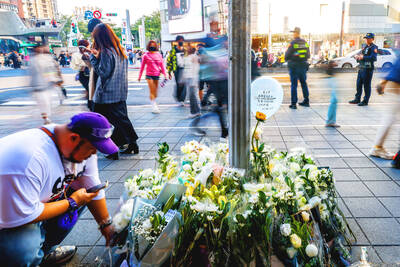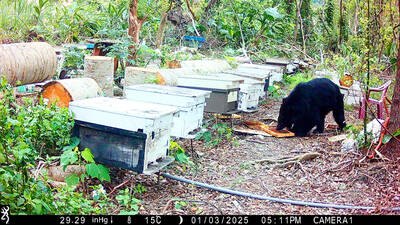The condition of a Taiwanese businessman who contracted the H7N9 avian influenza virus in China has improved to the point where he has been taken off his ventilator, and may soon be moved to a normal ward, National Taiwan University Hospital (NTUH) said on Tuesday.
“The patient has been taken off a ventilator, is no longer testing positive for the virus and has been taken off the anti-flu drug Tamiflu,” NTUH deputy superintendent Chang Shan-chwen (張上淳) said.
“If all goes well, the patient can be transferred to a normal ward in the next couple of days for continued treatment and recuperation,” Chang added.
The 53-year-old man, identified only by his surname, Lee (李), has been receiving intensive treatment in a negative pressure quarantine ward since April 20 after testing positive for the H7N9 virus following his return to Taiwan on April 9.
At the most serious stage of his illness, Lee was put on a ventilator and given extracorporeal membrane oxygenation (ECMO) therapy. He was taken off the ECMO, a machine that functions as an artificial lung, on Thursday last week.
“While the patient is clearly conscious and his health is improving steadily, he nevertheless remains weak and still suffers shortness of breath,” Chang said at a media briefing, with the consent of the patient’s family.
“It is still not clear when Lee can be discharged,” he added.
The H7N9 strain of bird flu had not been found in humans until cases were reported in China in April.
Scientists in China and other countries said the virus has jumped from birds, most probably chickens, to humans.
The virus has so far infected at least 129 people in China and killed 31 of them, according to the latest data from China’s health authorities and the WHO. To date, Taiwan is the only place outside China that has reported a case of H7N9.
Chang said that a sample of the virus obtained from Lee is likely to be used for virological study to analyze its genetic makeup, clinical symptoms and effectiveness of drug treatments.
A report from the Reuters news agency on Tuesday said that the WHO and the US Centers for Disease Control and Prevention have prepared samples of the virus to give to manufacturers for vaccine production.
New cell-culture technology developed by Novartis AG has reduced the production timeline for vaccines to a matter of weeks, although human safety trials will still require several months, the report said.
Major flu vaccine manufacturers include Sanofi SA, GlaxoSmithKline PLC, Novartis, Australia’s CSL Ltd, Baxter International Inc and AstraZeneca PLC, the report said.
The two main drugs that appear to be effective against H7N9 are Roche Holding AG’s Tamiflu and GlaxoSmithKline’s Relenza, the report added.

SHIPS, TRAINS AND AUTOMOBILES: The ministry has announced changes to varied transportation industries taking effect soon, with a number of effects for passengers Beginning next month, the post office is canceling signature upon delivery and written inquiry services for international registered small packets in accordance with the new policy of the Universal Postal Union, the Ministry of Transportation and Communications said yesterday. The new policy does not apply to packets that are to be delivered to China, the ministry said. Senders of international registered small packets would receive a NT$10 rebate on postage if the packets are sent from Jan. 1 to March 31, it added. The ministry said that three other policies are also scheduled to take effect next month. International cruise ship operators

HORROR STORIES: One victim recounted not realizing they had been stabbed and seeing people bleeding, while another recalled breaking down in tears after fleeing A man on Friday died after he tried to fight the knife-wielding suspect who went on a stabbing spree near two of Taipei’s busiest metro stations, Taipei Mayor Chiang Wan-an (蔣萬安) said. The 57-year-old man, identified by his family name, Yu (余), encountered the suspect at Exit M7 of Taipei Main Station and immediately tried to stop him, but was fatally wounded and later died, Chiang said, calling the incident “heartbreaking.” Yu’s family would receive at least NT$5 million (US$158,584) in compensation through the Taipei Rapid Transit Corp’s (TRTC) insurance coverage, he said after convening an emergency security response meeting yesterday morning. National

PLANNED: The suspect visited the crime scene before the killings, seeking information on how to access the roof, and had extensively researched a 2014 stabbing incident The suspect in a stabbing attack that killed three people and injured 11 in Taipei on Friday had planned the assault and set fires at other locations earlier in the day, law enforcement officials said yesterday. National Police Agency (NPA) Director-General Chang Jung-hsin (張榮興) said the suspect, a 27-year-old man named Chang Wen (張文), began the attacks at 3:40pm, first setting off smoke bombs on a road, damaging cars and motorbikes. Earlier, Chang Wen set fire to a rental room where he was staying on Gongyuan Road in Zhongzheng District (中正), Chang Jung-hsin said. The suspect later threw smoke grenades near two exits

The Forestry and Nature Conservation Agency yesterday launched a gift box to market honey “certified by a Formosan black bear” in appreciation of a beekeeper’s amicable interaction with a honey-thieving bear. Beekeeper Chih Ming-chen (池明鎮) in January inspected his bee farm in Hualien County’s Jhuosi Township (卓溪) and found that more than 20 beehives had been destroyed and many hives were eaten, with bear droppings and paw prints near the destroyed hives, the agency said. Chih returned to the farm to move the remaining beehives away that evening when he encountered a Formosan black bear only 20m away, the agency said. The bear